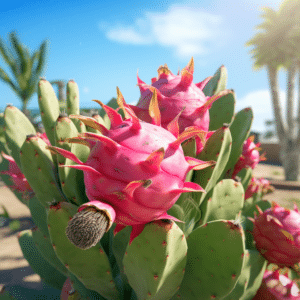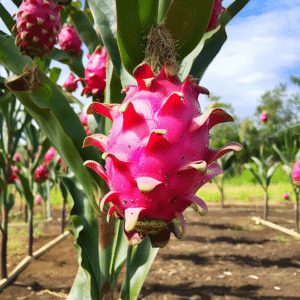Dragon fruit, also known as pitaya, is a unique and exotic fruit that is becoming increasingly popular among gardeners and fruit enthusiasts. While you can buy dragon fruit plants from nurseries, growing the plant from seed can be a rewarding and cost-effective way to expand your garden. In this step-by-step guide, we will explore the process of growing dragon fruit from seed, from understanding the characteristics of the fruit to troubleshooting common growing problems.
Understanding Dragon Fruit: Origin and Characteristics

Before diving into the process of growing dragon fruit from seed, it is important to understand the origin and characteristics of this fascinating fruit. Dragon fruit is native to Central America and belongs to the cactus family. It is a tropical fruit that comes in various vibrant colors, including red, yellow, and white. The unique appeal of dragon fruit lies not only in its appearance but also in its nutritional benefits.
Dragon fruit’s striking appearance, with its vibrant colors and unusual shape, makes it an eye-catching addition to any garden. The fruit’s exterior is characterized by scales, giving it a dragon-like appearance, hence its name. When cut open, dragon fruit reveals a white or pink flesh speckled with tiny black seeds. The texture of the flesh is often compared to a combination of kiwi and pear, with a mild, slightly sweet flavor.
But what makes dragon fruit truly fascinating is its rich history and cultural significance. The fruit has been cultivated for centuries in Central America, where it is not only cherished for its taste but also revered for its medicinal properties. Ancient civilizations believed that dragon fruit possessed mystical powers and used it in various traditional remedies.
One interesting aspect of dragon fruit is its adaptability to different climates. While it thrives in tropical regions, it can also be grown in subtropical and even temperate climates with proper care. This adaptability has led to the fruit’s spread across the globe, making it a popular choice among gardeners and fruit enthusiasts worldwide.
Nutritional Benefits of Dragon Fruit
Beyond its visual appeal, dragon fruit is also known for its numerous health benefits. It is low in calories and high in fiber, making it an excellent choice for those looking to maintain a healthy diet. The fruit is packed with vitamin C, antioxidants, and beneficial plant compounds, which contribute to its immune-boosting and anti-inflammatory properties. Additionally, dragon fruit contains several minerals, including iron, calcium, and phosphorus.
Furthermore, dragon fruit is a great source of dietary antioxidants, which help protect the body against harmful free radicals. These antioxidants play a crucial role in reducing the risk of chronic diseases, such as heart disease and certain types of cancer. Regular consumption of dragon fruit can also promote healthy digestion, thanks to its high fiber content.
Moreover, dragon fruit is an excellent choice for individuals looking to improve their skin health. The fruit’s high vitamin C content promotes collagen production, which helps maintain the skin’s elasticity and youthful appearance. Additionally, the antioxidants found in dragon fruit can help combat skin damage caused by environmental factors, such as pollution and UV radiation.
It is worth noting that dragon fruit’s nutritional benefits extend beyond its flesh. The seeds of the fruit are rich in healthy fats, including omega-3 and omega-6 fatty acids. These fats are essential for brain health and can help reduce the risk of heart disease. Including dragon fruit seeds in your diet can be a great way to reap these additional health benefits.
In conclusion, dragon fruit is not only a visually stunning fruit but also a nutritional powerhouse. Its vibrant colors, unique shape, and rich history make it a fascinating addition to any garden. Whether you are looking to enhance your diet or explore the world of exotic fruits, dragon fruit is definitely worth a try.
Preparing to Plant Your Dragon Fruit Seeds
Now that you have a basic understanding of dragon fruit, it’s time to prepare for the planting process. The first step is to choose the right dragon fruit seeds and gather the necessary equipment.
Choosing the Right Dragon Fruit Seeds
When selecting dragon fruit seeds, it is important to choose a variety that is suitable for your climate and growing conditions. There are several varieties available, each with its own unique characteristics. Some are better suited for cooler climates, while others thrive in warmer regions. Consider consulting local gardening experts or nurseries to determine the best variety for your location.
Necessary Equipment for Planting
In addition to choosing the right seeds, you will need to gather the necessary equipment for planting. This includes planting containers or pots, well-draining potting soil, a watering can or hose, and organic fertilizers. Ensure that the containers you choose have drainage holes to prevent waterlogged soil, which can be detrimental to the growth of dragon fruit.
The Planting Process: A Step-by-Step Guide

Now that you have everything prepared, it’s time to start the planting process. Follow these step-by-step instructions to ensure successful growth of your dragon fruit plants.
Preparing the Soil for Planting
Before planting your dragon fruit seeds, it is important to prepare the soil. Dragon fruit plants thrive in well-draining soil, so make sure the soil in your chosen planting containers is loose and airy. You can improve the soil’s drainage by adding perlite or sand. Additionally, it is beneficial to amend the soil with organic matter, such as compost or well-rotted manure, to provide essential nutrients for the growing plants.
Planting the Dragon Fruit Seeds
Once your soil is prepared, it’s time to plant the dragon fruit seeds. Place the seeds about half an inch deep into the soil, spacing them a few inches apart. Gently pat down the soil around the seeds to ensure good seed-to-soil contact. Water the soil lightly, being careful not to overwater, as excessive moisture can lead to rotting. Place the planted containers in a location that receives ample sunlight, preferably in a greenhouse or a sunny area indoors.
Caring for Your Dragon Fruit Plant
After planting the seeds, caring for your dragon fruit plants is crucial to their successful growth. Here are some essential care tips to keep in mind:
Watering and Fertilizing Your Dragon Fruit Plant
Dragon fruit plants require regular watering, especially during the growing season. It is important to keep the soil evenly moist but not waterlogged. During hot weather, the plants may need watering every few days, while in cooler months, less frequent watering may be required. Additionally, fertilizing your dragon fruit plant with organic fertilizers, such as compost or a balanced fruit tree fertilizer, can promote healthy growth and increase fruit production.
Pruning and Training Your Dragon Fruit Plant
To ensure strong and productive dragon fruit plants, pruning and training are essential. Prune your plants regularly to remove any dead or damaged parts and to maintain a compact shape. Additionally, provide support for the growing plants by installing trellises or stakes. Training the plant to grow vertically will help optimize space and promote better airflow, reducing the risk of disease and pest infestation.
Troubleshooting Common Dragon Fruit Growing Problems

Despite your best efforts, you may encounter certain issues while growing dragon fruit. Here are some common problems and their possible solutions:
Identifying and Treating Dragon Fruit Diseases
Diseases such as stem rot, root rot, or fungal infections can affect dragon fruit plants. Ensure proper drainage and avoid overwatering to prevent these problems. If disease does occur, remove the affected parts and treat with a suitable fungicide or organic disease control methods, such as neem oil or copper-based sprays.
Dealing with Pests that Affect Dragon Fruit
Dragon fruit plants can be susceptible to pests such as aphids, mealybugs, or scale insects. Regularly inspect your plants for signs of infestation, such as sticky or discolored foliage. If pests are present, use insecticidal soaps or natural predators like ladybugs to control their population. Alternatively, you can manually remove pests using a gentle spray of water or by handpicking them.
By following the step-by-step guide outlined in this article, you can successfully grow dragon fruit from seed and enjoy the satisfaction of harvesting your own delicious and nutritious fruits. Embrace the unique appeal of dragon fruit and reap the rewards of your garden endeavors!
